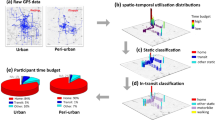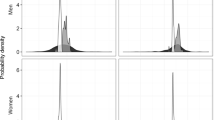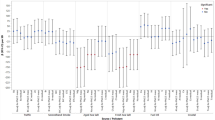Abstract
Various methods have been developed recently to estimate personal exposures to ambient particulate matter less than 2.5 μm in diameter (PM2.5) using fixed outdoor monitors as well as personal exposure monitors. One class of estimators involves extrapolating values using ambient-source components of PM2.5, such as sulfate and iron. A key step in extrapolating these values is to correct for differences in infiltration characteristics of the component used in extrapolation (such as sulfate within PM2.5) and PM2.5. When this is not done, resulting health effect estimates will be biased. Another class of approaches involves factor analysis methods such as positive matrix factorization (PMF). Using either an extrapolation or a factor analysis method in conjunction with regression calibration allows one to estimate the direct effects of ambient PM2.5 on health, eliminating bias caused by using fixed outdoor monitors and estimated personal ambient PM2.5 concentrations. Several forms of the extrapolation method are defined, including some new ones. Health effect estimates that result from the use of these methods are compared with those from an expanded PMF analysis using data collected from a health study of asthmatic children conducted in Denver, Colorado. Examining differences in health effect estimates among the various methods using a measure of lung function (forced expiratory volume in 1 s) as the health indicator demonstrated the importance of the correction factor(s) in the extrapolation methods and that PMF yielded results comparable with the extrapolation methods that incorporated correction factors.
This is a preview of subscription content, access via your institution
Access options
Subscribe to this journal
Receive 6 print issues and online access
$259.00 per year
only $43.17 per issue
Buy this article
- Purchase on Springer Link
- Instant access to full article PDF
Prices may be subject to local taxes which are calculated during checkout


Similar content being viewed by others
Abbreviations
- FEV1:
-
forced expiratory volume in 1 s
- F PEX :
-
fraction of ambient PM2.5 that a subject is exposed to
- EPA:
-
Environmental Protection Agency
- PM:
-
particulate matter
- PM2.5:
-
particulate matter less than 2.5 μm in diameter
- SD:
-
standard deviation
- PMF:
-
positive matrix factorization
References
Atkinson R.W., Anderson H.R., Sunyer J., Ayres J., Baccini M., Vonk J.M., Boumghar A., Forastiere F., Forsberg B., Touloumi G., Schwartz J., and Katsouyanni K. Acute effects of particulate air pollution on respiratory admissions. Results from APHEA 2 project. Am J Respir Crit Care Med 2001: 164: 1860–1866.
Carroll R.J., Ruppert D., and Stephanski L.A. Measurement Error in Nonlinear Models. Chapman and Hall, London, 1995.
Dockery D.W., and Pope III C.A. Acute respiratory effects of particulate air pollution. Annu Rev Public Health 1994: 15: 107–132.
Ferro A.R., Kopperud R.J., and Hildemann L.M. Source strengths for indoor human activities that resuspend particulate matter. Environ Sci Technol 2004: 38 (6): 1759–1764.
Fraser G.E., and Stram D.O. Regression calibration in studies with correlated variables measured with error. Am J Epidemiol 2001: 154: 836–844.
Fuller W.A. Measurement Error Models. John Wiley & Sons, New York, 1987.
Gauderman W.J., McConnell R., Gilliland F., London S., Thomas D., Avol E., Vora H., Berhane K., Rappaport E.B., Lurmann F., Margolis H.G., and Peters J. Association between air pollution and lung function growth in Southern California children: results from a second cohort. Am J Respir Crit Care Med 2002: 166 (1): 74–84.
Hopke P.K., Ito K., Mar T., Christensen W.F., Eatough D.J., Henry R.C., Kim E., Laden F., Lall R., Larson T.V., Liu H., Neas L., Pinto J., Stolzel M., Suh H., Paatero P., and Thurston G.D. PM source apportionment and health effects: 1. Intercomparison of source apportionment results. J Expo Sci Environ Epidemiol 2006: 16: 275–286.
Hopke P.K., Ramadan Z., Paatero P., Norris G.A., Landis M.S., Williams R.W., and Lewisc C.W. Receptor modeling of ambient and personal exposure samples: 1998 Baltimore particulate matter epidemiology-exposure study. Atmos Environ 2003: 37: 3289–3302.
Paatero P., Hopke P.K., Begum B.A., and Biswas S.K. A graphical diagnostic model for assessing the rotation in factor analytical models of atmospheric pollution. Atmos Environ 2005: 39: 193–201.
Pope C.A., Burnett R.T., Thun M.J., Calle E.E., Krewski D., Ito K., and Thurston G.D. Lung cancer, cardiopulmonary mortality, and long-term exposure to fine particulate air pollution. J Am Med Assoc 2002: 287: 1123–1141.
Rabinovitch N., Strand M., and Gelfand E.W. Particulate levels are associated with early asthma worsening in children with persistent disease. Am J Respir Crit Care Med 2006: 173: 1098–1105.
Rabinovitch N., Zhang L., Murphy J., Vedal S., Dutton S.J., and Gelfand E.W. Health effects of wintertime ambient air pollution on children with moderate to severe asthma. J Allergy Clin Immunol 2004: 114: 1131–1137.
Roemer W., Hoek G., and Brunekreef B. Effect of ambient winter air pollution on respiratory health of children with chronic respiratory symptoms. Am Rev Respir Dis 1993: 147: 118–124.
Sarnat J.A., Long C.M., Koutrakis P., Coull B.A., Schwartz J., and Suh H.H. Using sulfur as a tracer of outdoor fine particulate matter. Environ Sci Technol 2002: 36: 5305–5314.
Strand M., Vedal S., Rodes C., Dutton S.J., Gelfand E.W., and Rabinovitch N. Estimating effects of ambient PM2.5 exposure on health using PM2.5 component measurements and regression calibration. J Expo Sci Environ Epidemiol 2006: 16: 30–38.
US Environmental Protection Agency. Air Quality Criteria for Particulate Matter, National Center for Environmental Assessment, Research Triangle Park, NC, 2004 report no. EPA/600/P-99/002bF.
Vedal S., Petkau J., White R., and Blair J. Acute effects of ambient air particles in asthmatic and nonasthmatic children. Am J Respir Crit Care Med 1998: 157: 1034–1043.
Wallace L., and Williams R. Use of personal–indoor–outdoor sulfur concentrations to estimate the infiltration factor and outdoor exposure factor for individual homes and persons. Environ Sci Technol 2005: 39 (6): 1707–1714.
Wilson W.E., and Brauer M. Estimation of ambient and non-ambient components of particulate matter exposure from a personal monitoring panel study. J Expo Sci Environ Epidemiol 2006: 16: 264–274.
Wilson W., and Suh H. Fine particles and coarse particles: concentration relationships relevant to epidemiologic studies. J Air Waste Manage Assoc 1997: 47: 1238–1249.
Yakovelva E., Hopke P.K., and Wallace L. Receptor modeling assessment of PTEAM data. Environ Sci Technol 1999: 33: 3645–3652.
Zhao W., Hopke P.K., Gelfand E.W., and Rabinovitch N. Use of an expanded receptor model for personal exposure analysis in schoolchildren with asthma. Atmos Environ 2007 (in press).
Zhao W., Hopke P.K., Norris G., Williams R., and Paatero P. Source apportionment and analysis on ambient and personal exposure samples with a combined receptor model and an adaptive blank estimation strategy. Atmos Environ 2006: 40 (20): 3788–3801.
Acknowledgements
This work was funded in part by grants EPA R 825702 and Thrasher Research Fund 02816-8. We thank RTI International for their valuable help in providing the personal monitors, advice on implementation and interpretation of the personal monitoring protocol and gravimetric analysis. We also thank the Desert Research Institute for performing the XRF and IC analyses. Last but not least, we thank the children from the Kunsberg School for participating in the study and making these analyses possible.
Author information
Authors and Affiliations
Corresponding author
Appendix
Appendix
Steps in estimating λ
Perform a mixed model regression of total personal PM2.5 on ambient PM2.5, where fixed and subject-specific random terms for both the y-intercept and slope of ambient PM2.5 are included in the model. If nonambient and ambient PM2.5 exposures are approximately independent of each other, which our data suggested (also see Wilson and Suh, 1997), then the personal slope (fixed slope plus subject-specific random slope) indicates the average fraction of ambient PM2.5 that the subject is exposed to within the study period, whereas the y-intercept indicates average exposure to nonambient sources.
Repeat previous step, with the PM2.5 component of interest (e.g., sulfate).
The estimate of λ for a given subject is then obtained by dividing the personal PM2.5 slope by the personal PM2.5 component of interest (e.g., sulfate) slope.
The common λ can be obtained by averaging subject-specific estimates. A total of 21 subjects with low environmental tobacco smoke exposure were used to estimate λ.
Further detail is given in Strand et al. (2006), including a description of subjects used in estimating λ.
Rights and permissions
About this article
Cite this article
Strand, M., Hopke, P., Zhao, W. et al. A study of health effect estimates using competing methods to model personal exposures to ambient PM2.5. J Expo Sci Environ Epidemiol 17, 549–558 (2007). https://doi.org/10.1038/sj.jes.7500568
Received:
Accepted:
Published:
Issue Date:
DOI: https://doi.org/10.1038/sj.jes.7500568
Keywords
This article is cited by
-
Health effects of concurrent ambient and tobacco smoke-derived particle exposures at low concentrations in children with asthma
Journal of Exposure Science & Environmental Epidemiology (2020)
-
Within-microenvironment exposure to particulate matter and health effects in children with asthma: a pilot study utilizing real-time personal monitoring with GPS interface
Environmental Health (2016)
-
Effect measure modification of blood lead–air lead slope factors
Journal of Exposure Science & Environmental Epidemiology (2015)
-
Using Global Positioning Systems (GPS) and temperature data to generate time-activity classifications for estimating personal exposure in air monitoring studies: an automated method
Environmental Health (2014)
-
Exposure prediction approaches used in air pollution epidemiology studies: Key findings and future recommendations
Journal of Exposure Science & Environmental Epidemiology (2013)



